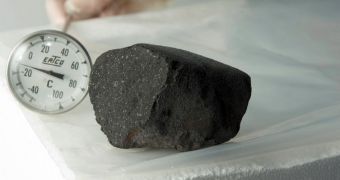Molecules without which life would have not appeared and developed on Earth appear to be produced in large quantities on asteroids. The space rock then spread their “products” via meteorites through solar systems, and on nearby planets. The same thing happened on Earth.
Even now, molecules produced by these cosmic assembly lines are being delivered to our planet via meteorites and small scale space impactors. In a new study, experts have shown that not only asteroids produce important molecules, they also make changes to the latter's composition on-the-go.
The research was based on data collected from meteorite fragments recovered from the frozen surface of Tagish Lake, in northern British Columbia, Canada. The rock fragments were produced as a large meteoroid exploded over the area back in January, 2000, spreading debris all over the place.
Many of the fragments landed on the frozen surface of the lake. Many people who witnessed the explosion rushed to the scene, and collected samples. These are the best-preserved chunks of meteorite in the entire world, experts say.
In the new study, led by scientists at the University of Alberta in Edmonton, the chemical composition of the frozen meteorites was analyzed. The team says that only negligible contamination occurred in the space rocks, on account of them being frozen.
“The first Tagish Lake samples – the ones we used in our study that were collected within days of the fall – are the closest we have to an asteroid sample return mission in terms of cleanliness,” says NASA Goddard Space Flight Center (GSFC) expert Dr. Michael Callahan, a coauthor of the new study.
The work was led by Dr. Christopher Herd of the University of Alberta. He is also the lead author of the research paper, which is published in the June 10 issue of the top journal Science.
In addition to carbon, experts also found amino-acids in the samples. These molecules are the basic building blocks of proteins, some of the most important components of lifeforms in general. Interestingly, some of the samples contained a lot more amino-acids than others.
“We see that some pieces have 10 to 100 times the amount of specific amino acids than other pieces. We've never seen this kind of variability from a single parent asteroid before,” says GSFC expert and paper coauthor Dr. Daniel Glavin.
“Only one other meteorite fall, called Almahata Sitta, matches Tagish Lake in terms of diversity, but it came from an asteroid that appears to be a mash-up of many different asteroids,” she adds.
“Our research provides new insights into the role that water plays in the modification of pre-biotic molecules on asteroids. Our results provide perhaps the first clear evidence that water percolating through the asteroid parent body caused some molecules to be formed and others destroyed,” Herd says.
“The Tagish Lake meteorite provides a unique window into what was happening to organic molecules on asteroids four-and-a-half billion years ago, and the pre-biotic chemistry involved,” he concludes.

 14 DAY TRIAL //
14 DAY TRIAL //